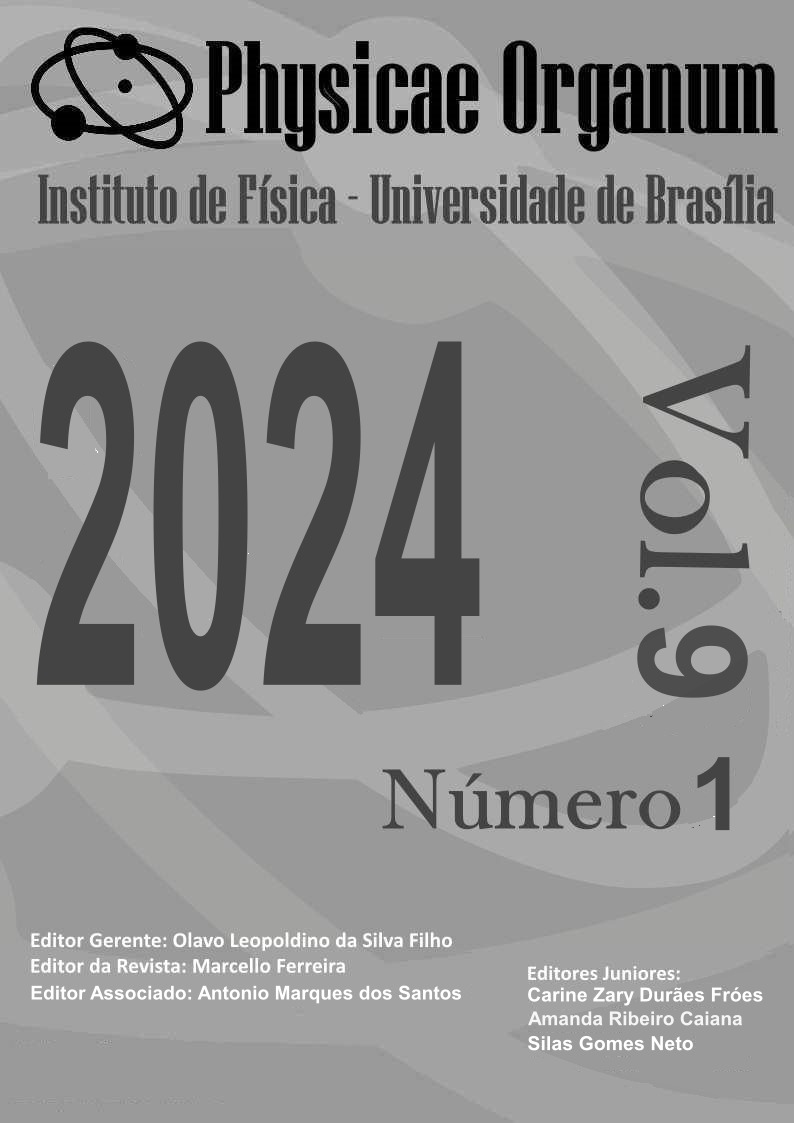Two-body problem. Part I: Newtonian theory and Kepler's laws
DOI:
https://doi.org/10.26512/2446-564X2024e48991Keywords:
Classical Mechanics, Gravitational force, Two-body problem, Precession of perihelionAbstract
In this paper, which contains the part $1$ of a long work on the classical problem of the motion of two bodies atracting each other mutually through forces acting along the straight-line joining them, we present a complete text, rich in technical details on the gravitational problem of two bodies interacting via Newton's universal law of gravitation (1687), which certainly will be useful as a didatic material for both teachers and students enrolled in Classical Mechanics courses. After finding the exact analytical solution for the equation of motion and all its corresponding trajectories, we show that the bounded periodic orbits which are non-circular are always elliptic ones without any advance of the perihelion, in full agreement to the three Kepler laws. We also indicate how to find the results corresponding to the electrodynamics analogous, i.e., when two charged corpuscles attract themselves with Coulomb's force. In the part $2$, to be published in this same journal, we shall present the unpublished translation from German to Portuguese of Einstein's original paper (1915), in which he applies his General Theory of Relativity to get an approximate solution to the relativistic gravitational two-body problem, which led to elliptic orbits with a rate for the precession of the perihelion that is in good agreement to that observed for Mercury, but not for the other planets of the solar system. At last, in part $3$ we shall present the exact solution yielded by Assis's Relational Mechanics (1989), which will allow us to compare the theoretical models from Newton, Einstein and Assis, showing that, though the last two models furnish the same rate of precession ($43$''/century), the equations of motion are not identical. We shall also show that the advance of the perihelion predicted by Relational Mechanics takes place with respect to the fixed stars, just as it has been observed and measured by astronomers, contrarily to which is found in relativistic models.
Downloads
References
J. Kepler, New Astronomy [Astronomia Nova, 1609]. Translated by W. H. Donahue, Cambridge: Cambridge University Press, 1992. 54
I. Newton. Principia – Princípios Matemáticos de Filosofia Natural. Livro I: O Movimento dos Corpos. São Paulo: Nova Stella/Edusp, 1990. [Tradução da 3a edição [1726] por T. Ricci, L. G. Brunet, S. T. Gehring e M. H. C. Célia] 54, 55, 56, 60
I. Newton. Principia – Princípios Matemáticos de Filosofia Natural. Livro II: O Movimento dos Corpos (em Meios com Resistência) e Livro III: O Sistema do Mundo (tratado matematicamente). São Paulo: Edusp, 2008. [Tradução da 3a edição (1726) por A. K. T. Assis] 54, 58, 60
J. Barrow-Green, The Three-Body Problem. In T. Gowers, J. Barrow-Green, and I. Leader (eds.), The Princeton Companion to Mathematics. New York: Princeton University Press (2008), pp. 726–728. 54
J. Bernoulli, “Extrait de la réponse de M. Bernoulli à M. Herman”, datée de Basle le 7, Octobre 1710. Memoires de l’Ac. Royale des Sciences Boudot Paris, 1710 (1712). 55
MicroSCOPE Satellite Mission (CNES/ESA), 2017. Disponível em: https://directory. eoportal.org/web/eoportal/satellite-missions/m/microscope 58
J. Kepler. Harmonices Mundi (1619), p. 189–190. 63
M. F. Ferreira da Silva, “Quantidades médias no movimento de um corpo em trajetória elíptica”, Rev. Bras. Ens. Fís. 33(3), 3315 (2011). 63
D. M. Williams, “Average distance between a star and planet in an eccentric orbit”, Am. J. Phys. 71(11), 1198–1200 (2003). 63
N. M. Swerdlow, “Kepler’s iterative solution to Kepler’s equation”, Journal for the History of Astronomy 31(4), 339–341 (2000). 65
J. F. Ritt, “Elementary functions and their inverses,” Trans. Amer. Math. Soc. 27, 68 (1925). 65
Downloads
Published
How to Cite
Issue
Section
License
Copyright (c) 2024 Physicae Organum

This work is licensed under a Creative Commons Attribution-NonCommercial-ShareAlike 4.0 International License.
Autores que publicam nesta revista concordam com os seguintes termos:
- Autores mantém os direitos autorais e concedem à revista o direito de primeira publicação, sendo o trabalho simultaneamente licenciado sob a Creative Commons Attribution License o que permite o compartilhamento do trabalho com reconhecimento da autoria do trabalho e publicação inicial nesta revista.
- Autores têm autorização para assumir contratos adicionais separadamente, para distribuição não-exclusiva da versão do trabalho publicada nesta revista (ex.: publicar em repositório institucional ou como capítulo de livro), com reconhecimento de autoria e publicação inicial nesta revista.
- Autores têm permissão e são estimulados a publicar e distribuir seu trabalho online (ex.: em repositórios institucionais ou na sua página pessoal) a qualquer ponto antes ou durante o processo editorial, já que isso pode gerar alterações produtivas, bem como aumentar o impacto e a citação do trabalho publicado (Veja O Efeito do Acesso Livre).




